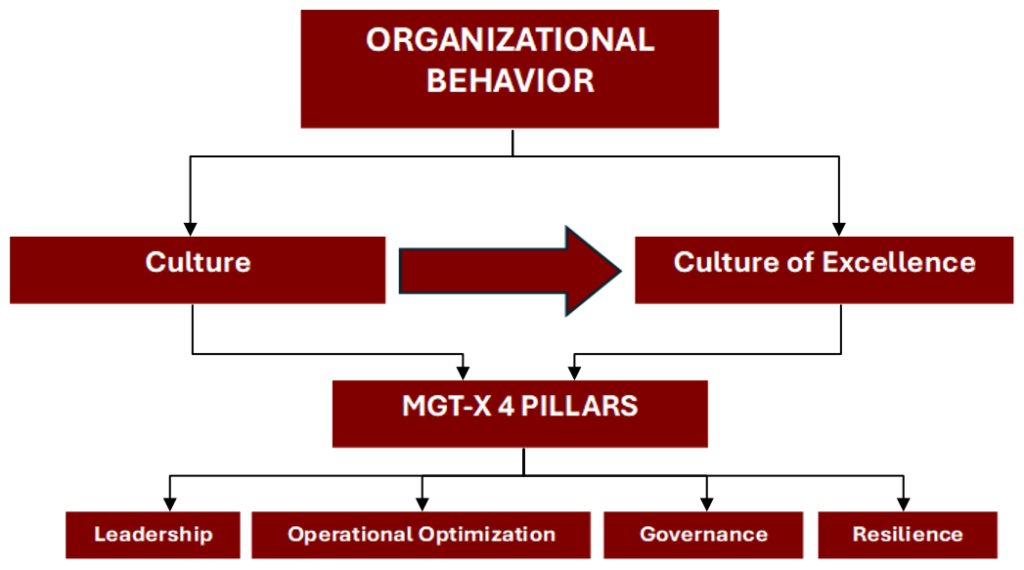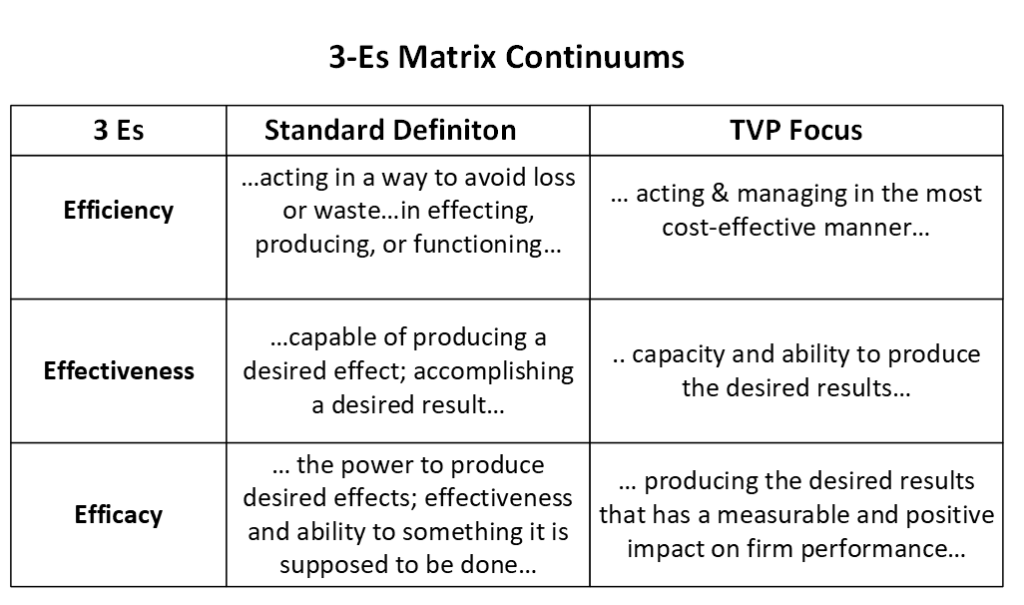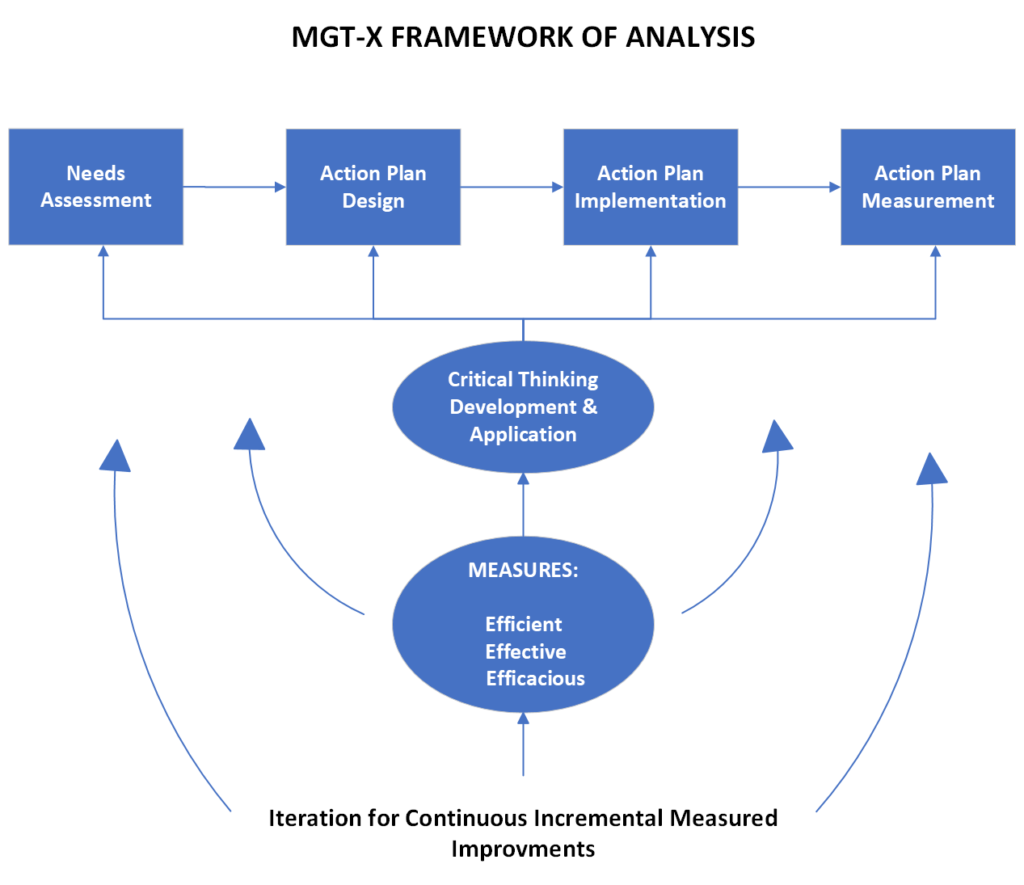INTRODUCTION – PART 1
All the previous Ports of Call have provided snapshots of concepts that impact firm value. These are technical in nature and application, which leads to the use of a firms EBITDA as a surrogate for firm cashflows. In turn, this renders a concise equation for firm value:
Implied Firm Value = EBITDA x Multiple (Based on Cost of Capital)
We will return to the financial concepts and introduce the Well-Run Company Model (WRC). TVP’s Well-Run Company Model is defined as a firm that produces an “indicated or implied value” at which the owner would sell at a given point in time. The WRC Model is based on the concept that value creation requires excellent management that must be considered an investment in the firm, manifested in cash flows and reduced risk . These are not accounting driven metrics, but those of Managerial Excellence to which we now turn.
MANAGERIAL EXCELLENCE (Mgt-X)
Mgt X refers to the not only the quantity of management skills deployed and used in firm operations, but more importantly the quality of such management. Mgt X is to the overall performance of the firm. It is analogous to the firms Cap X (Capital Expenditures) as investment in firm operations from plant and equipment, applied technology, and investment in training and retention of human resources. Without Cap X a firm cannot obtain or retain long-term strategic advantage over industry rivals. Nor can it do so without Mgt X. The firm must invest in Mgt X to obtain sustained competitive advantage over rivel firms (Porter).
The TVP concept is that Mgt X must be consistently applied to all facets of the firm operations and activities to optimize firm value. Such focus must be seen and measured by the return on such investment (ROI).
TVP FOCUS: ORGANIZATIONAL BEHAVIOR: BUILDING a CULTURE of EXCELLENCE THROUGH INVESTMENT IN MGT-X

Organizations exhibit behaviors which are derivative of their cultures, both bad and good. The goal is to develop a sustained “culture of excellence” in all areas of firm activities. (Peters 1985). This does not happen by accident or luck, but through a robust investment of time and resources in the MGT-X 4 Pillars noted above and discussed below. It starts with leadership and a commitment to invest in MGT-X.
KEY ELEMENTS of MANAGERIAL EXCELLENCE
The TVP MGT-X Model finds that the essential elements of sustained Managerial Excellence include Leadership, Operational Optimization, Corporate Governance, and Resilience Planning & Building.
- LEADERSHIP (L) is the most important element in any business. There is no shortage of practitioner and academic studies on leadership and its impact on firm performance (Peters, et al). The TVP MGT-X Model focuses on Stewardship (Block 1996) as the leadership model of choice because it is practical and inspirational at the same time. It isn’t necessarily easy or often observed in practice because it requires the owner, who is often the CEO, to be dedicated to the idea of service to the firm over self-interest and requires the development of critical thinking skills.
- OPERATIONAL OPTIMIZATION (OOP) is doing the day to day management of the firm in a form, design and execution that optimizes the firms cash flows and EBITDA. This requires that every firm department, operation, activity, manager, and employee must be assessed by efficiency, effectiveness, and efficacy metrics. It is a difficult task, but a necessary one. It is developed by investing in the development and training in needed employee skills.
- CORPORATE GOVERNANCE (CG) refers to the non-operational but critical administrative functions of the firm from record keeping, to shareholder relations, compliance with legal requirements, and succession considerations. For private companies, firm making sure that shareholders agreements, key-person life insurance and succession plans are in place, signed and financed.
- RESILIENCE PLANNING and BUILDING (RPB) goes beyond the normal operational risk management activities and extends to examining the potential risks to the company, even existential ones. If Covid taught managers anything, it is the need to plan for even the unexpected instead of just reacting to events. In planning for threats, the goal is to build a firm that is resilient to such risks should they occur so the firm can survive them.
INTRODUCTION – PART 2: IMPLEMENTATION of MGT-X & Its 4 PILLARS
POC 6 Part 1 explored and emphasized the important of Mgt-X and its 4 Pillars of Leadership, Operational Optimization, Governance, and Resiliency in producing greater firm value. It is a call to action by owners and managers to make the needed investments in MGT-X.
POC 6 Part 2 focuses on designing, implementing and measuring the results of every action plan.
APPLICATION of CRITICAL THINKING SKILLS
Managers must think critically in practice because of the gap between the perfect world vs. real world development, application and measurement of real- world actions plans to improve firm performance and value.
THE 3 Es
The connective tissue between MGT-X and action plans are the 3 Es of Efficiency, Effectiveness, and Efficacy. results as the continuum of the 3 Es: Efficiency, Effectiveness, and Efficacy. The following matrix sets forth the standard and commonly used definitions of each “E” and the applied TVP Focus. The definitions are taken from the Merriam-Webster Dictionary (www.merriam-webster.com). The TVP focus extends the definition to apply to the challenges of becoming a well-run company.
The importance of Investing in Mgt.- X and it’s 5 pilers has been presented. These concepts are important for owners and managers to understand as the key drivers of the growth of firm value, but also represent a call to action to embrace and effectuate Mgt-X and a framework for the actions to be taken. The actions must be the right ones that when designed and implemented properly will result in enhancement of firm efficiency, effectiveness, and efficacy. These terms are often used in both practitioner and scholarly literature but are left wanting in terms of details. In the TVP Model is presented in the following metric and narrative.

Notice that the 3 Es are linked. All three must have measurements of desired results of action plans. Is each plan:
- Efficient in terms of the cost/benefit ratio?
- Effective producing the desired results?
- Efficacious in producing greater firm cash flows (EBITDA)?
AN INTERATIVE PROCESS
More importantly, it must be recognized that the process of designing a plan, implementing it and measuring the results is iterative. Most often there will be a gap between what is achieved compared to the desired goal, which begets further actions plans and a never-ending journey to become a well-run company with a culture of excellence.

SUMMARY
The elements of managerial excellence are the cornerstones upon which firm value is built. When Leadership is combined with Operation Optimization, Corporate Governance, and Resilience Planning & Building they can enhance the EBITDA and grow firm value. All starts with Leadership, which requires a committed investment in MGT-X, which has an associate Cost of Capital and ROI. MGT-X is the key to achieving Well-Run Company status and achieving growth of firm value.
TVP returns to these concepts in future writings.

To reach optimum EBITDA requires a robust, orchestrated and lasered focus on Managerial Excellence factors and the investment therein, especially Leadership.
References & Further Reading:
- Porter, Michael E., On Competition, ( 1995-2008), Harvard Business School Publishing Corporation, Boston, MA. See especially, Part I: Competition & Strategy: Core Concepts; Chapter 1: “The Five Forces That Shape Strategy”, Pages 3-36.
- Peters, Thomas J. and Robert H. Waterman, Jr., In Search of Excellence, (1982),Harper & Row, N.Y., N.Y. Also see Peters, Thomas J. & Nancy Austin, A Passion for Excellence: The Leadership Difference, (1985), Random House, N.Y., N.Y. and Peters, Thomas J. & Robert H. Waterman, Jr., In Search of Excellence: Lessons from America’s Best Run Companies, (2006), Harper Collins, N.Y., N.Y.
- Block, Peter, Stewardship, (1993, 1996), Berrett-Koehler Publishers, Inc., San Francisco, CA.
